How to Remove Paint from Wood: Tutorial & Products
We put together a quick guide on how to remove paint from wood. Find out the products you will need and how to do it DIY at home.
That piece of wood furniture you acquired a few years ago is a gem. The wood kitchen cabinets are treasure too just that their real beauty is hidden under layers of paint. You can rejuvenate the wood by repainting, but all new paint ages. It cracks and blisters and eventually begs to come off. However, if you can remove all that dull paint, lustrous hardwood would beam through. You would be free to paint it as you please or just finish it with a shimmering vanish.
Stripping paint off wood is a rather tedious and messy process. For a cleaner, safer, and more effective job, you need to find an appropriate way to strip the wood and contain the debris. Often the best way to remove paint from wood involves balancing your desire for a gorgeous piece with the patience of scraping and using chemicals.
However, before you even get to strip the surfaces, you need to determine whether a piece needs exposing. Find a hidden place on the furniture and scrape a test patch. If the bottom layer is paint, then the piece isn’t worthy of stain.
Moving on to paint removal, start by ensuring the surface is not wet. You can dry the surface with a hair dryer or a piece of cloth. You can also use a heat gun, but be cautious. Keep a safe distance from the door to avoid burn marks and always use protective gear.
There are various methods you can use to remove paint from wood.
1. Sanding
You will need sandpaper with two choices of grain. You will also need a fair supply of them. The first grain should be coarse for the initial work. That is to remove the old paint. The second grain should be much smoother for a smoother finish on the wood underneath. Take your time when sanding as friction causes heat which will damage your piece.

Using sandpaper though is tedious, time-consuming, and rather frustrating. The paper clogs up with paint in no time. You would be better off using an electric sander. It will be much easier and faster to get rid of the initial paint. All you have to is finish the wood with a smooth-grain sandpaper. Ensure you are following the wood grain lest you damage it.
Finally, dust the wood with a cloth imbibed in paint solvent, and sweep any dust or paint on the floor.
2. Use a Heat-Gun
A heat gun is a faster way to remove paint from wood but is also quite dangerous. You want to ensure you have your gloves, face mask, and goggles on. Have some water close by in case any surface catches fire.
Start by positioning the heat gun about between 15cm and 20cm away from the surface. Switch the apparatus and warm small places using side to side and up down motions. Keep at it until the surfaces start to become tender. Use a broad paint scraper to remove the paint as it bubbles and wrinkles.
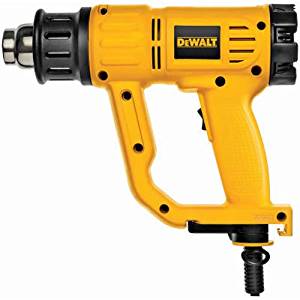
Move to the next patch of paint and follow the same procedure. You will have to sand the wood for a much smoother finish and to get rid of the paint you couldn’t scrape off.
3. Using a Chemical Stripper
Things might get a bit bumpy and you will have to resort to chemical methods. Ensure you get the right type of stripper as some vary in usage. Thoroughly read the instructions since despite the application being the same for most strippers but the details can vary. Liquid strippers can be applied using a paintbrush or a spray can. Shake the stripper well and pour it into a bucket or a spray can. Using a paintbrush, coat the entire painted surface and then leave it for about 30 minutes to 1 hour. When coating the surfaces, make sure you are painting in one direction.
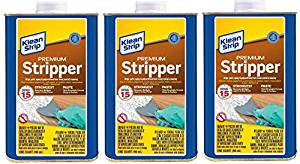
Use a scraper to test if the stripper has worked. It should cut through the paint without a problem. Proceed to scrape the paint, sand, and clean the surface with a cloth soaked in paint solvent.
4. Scraping
This is only ideal where you are dealing with a thick layer of paint, or it’s in large amounts. Start by sharpening your scraper in a motion that sharpens the tip. Sharpen both sides of the tip. If scraping becomes a bit difficult, try dousing the surface with water, vinegar or spirit. These liquids will help soften the paint. You will notice that the scraper is blunt again. Keep sharpening it to ease the work.

Be careful when scraping. You don’t want to damage the wood. To reduce the likelihood of you damaging the underlying wood, scrape paint off in a straight position and do it calmly. Finally, sand the object and clean with a cloth doused in paint solvent.
Products You Can Use to Remove Paint from Wood
Heat Gun
While a heat gun is a versatile and powerful tool, it can be a hassle to land one that is ideal for stripping paints seeing as they are used to thermally process a range of materials. They are safe to operate as they don’t produce an open flame but one should still be careful when using them.
Below is what to look for if you want to get an appropriate heat gun to remove paint.
Temperature Control
Although it’s available in most heat guns, the options differ. We advise you get one with more heat control options. First, the temperature needed to remove the paint depends on the type of coating used, and the surface. Purchasing a heat gun with greater temperature variability allows you to work on different surfaces and paints. However, it will be more expensive. Guns that produce higher temperature are also a bit costly.
Nozzle Choices
You can find a standard wide nozzle on any heat gun. However, there are instances you might want to direct the heat in a particular way; maybe you want to remove paint from a tight spot where a standard nozzle cannot gain access. Some of these nozzles will be a part of the package while you will have to purchase the rest. Before you go looking for additions, look into various heat guns for one that might meet your needs. Otherwise, here are the various nozzle choices.
Cone Nozzle to reduce the concentrated heat as it features a reduced output size, a fishtail nozzle to spread the heat to cover a wide area, and a flat or surface nozzle that can concentrate or spread the heat depending on the detailed measurement.
You can also look for a glass protector to remove adhesive or paint on glass. It avoids overheating thus protecting your windows.
Additional Features
The heat gun you purchase should be determined by the features of the item. Features, on the other hand, depending on how you intend to use the heat gun and how frequent. With limited applications and less frequent use, a heat gun with limited features will suffice. Nevertheless, if you are looking for something more, below are some features you can consider.
Thermal Cutout – For safety purposes, purchase a tool with a thermal cutout as it will shut off if the tool overheats or malfunctions.
Auto-calibration – Allows the tool to adjust the temperature based on the surface or the temperature of the surface.
Look for air flow setting if you want to control the fan and rate of airflow.
Surface Stand – Purchase a tool with a surface stand for a place to rest the gun while it’s still hot or for a hands-free removal option.
Ceramic heating element – If you want to work on any ceramic surface without damaging it. It also increases the longevity of the item.
Before you purchase a heat gun, ensure you have a checklist of all the qualities you desire. Your checklist should be based on the needs and preferences of the user, usage of the item, the paint you intend to remove and the surface you want to use it on. Ensure the gun is of manageable weight, and that it has an ergonomic design. The design allows comfortable use of the tool. Finally, ensure it is well-matched with the power source and check the warranty and repair instructions thoroughly.
Our pick for the best heat gun paint removal is the Wagner 0503008 HT1000.
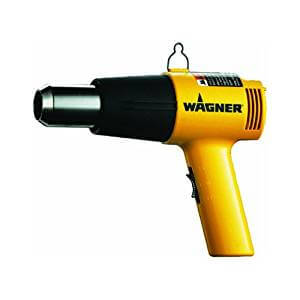
Its nozzle is corrosive resistant which increases the longevity of the product. It has an ergonomic design for comfortable use and is lightweight. It’s also a low noise design and can be used in noise-sensitive areas such as offices and households. Has a two fan speed and can remove multiple layers of paint at once.
As for the cons, it lacks a hook for storage or hanging when hot. It also does not sit upright and has hot spots.
For a more powerful tool, you might want to consider the Porter Cable PC 1500HG. It features a powerful 1500W motor and delivers a higher temperature than the Wagner heat gun. You can, therefore, use it to remove tough paints. It also features a variable temperature control, incremental tuning, and a dual fan speed. Unlike the previous tool, it has a stand allowing for hands-free operation. A high-quality plug is also incorporated into the tool, a hook for hanging, and 6 ft cord for greater distance. You also don’t have to worry about arm fatigue as it only weighs 2-pounds.
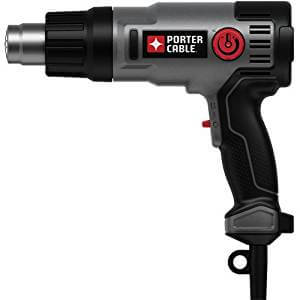
Infrared Devices
Infrared technology in paint removal has gained popularity in the past few years thanks to its safe nature. Unlike heat guns, there is a lower risk of burning your wood and it also does not produce dust like some mechanical methods such as sanding. Also, it does not leave you with a chemical problem that has to be neutralized. Infrared devices also work faster than most paint stripping methods. A 30-second blast can loosen decades-old paint. The temperature is often below 500®F, which is well under the temperature at which wood ignites. Also, the heat will draw moisture from the wood increasing its ability to absorb and hold new paint.
Our pick for the best infrared paint stripper is the Speedheater Cobra. First, it’s small in size and you don’t have to worry about fatigue when using it. It heats paint quickly in 2 to 4 seconds so you don’t have to worry about the time it will take to complete a project. Also, it can reach tight spots making it ideal for windows and it is easy to transport, unlike the original Speedheater. However, there is one shortcoming in that it has no carrying case. LED bulbs are expensive and it would be ideal if there was a case for their safe transport.
Steam Strippers
If you want to eliminate the likelihood of burnt wood, look into steam strippers. These use water vapor to loosen the bond between the paint and the wood. It has several advantages one being that it eliminates dust and fumes. This is a big deal especially in houses full of lead paint. Second, it eliminates any fire risks. There is little or no chance of scorching your wood surfaces. The water is heated to 212®F which is not high enough to damage the wood.
By and large, it is simple and effective and relatively inexpensive as you don’t have to worry about purchasing replacement blades. The only disadvantage is that they are not ideal for removing paint on windows. You will have to invest in an expensive steam box or construct yours.
Sanders
Most homeowners have a love-hate relationship with sanding. The process is tedious dirty work and one makes excruciatingly slow increments. It is quite time-consuming compared to using a heat gun or chemical methods. However, it’s more intimate. It puts you in touch with the product and the work in a way only continuous repetition can. The results of sanding are also more pleasant. It will knock down all marks, remove blemishes, fillers and even up pieces, which is why all other paint removal approaches have to end with sanding. It also allows a new finish to penetrate by opening the wood grain.
However, it will be hard to enjoy sanding or even get the desired results without the appropriate tools.
Before you purchase the tool though, look at:
Safety – With any difficult activity, it’s very difficult for the worker to leave without some damage. One can burn themselves with a heat gun while sanding using a sandpaper leads to blisters. A sander though has none of the above. It leads to a hazard-free sanding.
Comfort – Remember that sanding is time-consuming. Progress will be excruciatingly slow and therefore the tool you choose should cause little or no fatigue increasing the productivity of an individual.
Productivity – You want a sander that removes paint over a large area in little or no time.
Attachment options – You also want to look into the attachment options a sander has. Fittings can boost your productivity while reducing your work. One such attachment is the dust collection system. It collects dust at the source reducing the amount of clean-up required.
Random Orbital Sander
The random orbital sander is ideal if you have a lot of sanding to go through. First, it is quite versatile owing to its unique motion. The pad moves in an oval direction while the sandpaper disc moves in circular motion. The result is that no abrasive particle will follow the same path twice and thus a swirl free finish. Also, we advise you pick the 6” right angle orbit sander which unlike the 5” sander, has more juice to work accurately and faster. You can also use the different settings available. It is adaptable for a finer finish or you can use a wood setting. Our top picks for random orbit sanders are:

If you have a lot of sanding to be done in a day, you might want to look into this tool. It is such a robust tool that it can handle 10+ hours of work and still achieve the same great results. Black and Decker have focused on improving the ergonomics, convenience and the compact size of their products. As a result, you don’t have to worry about comfort and storage of the device. To make changing paper effortless, the BDero 100 features a hook and loop system which is effective and easy to work with. It’s also available with a 5Amp battery, a vital part of any sanding tool.
Also, the tool features a four-position blade clamp. You can install the blade sideways facing right or left, or upright facing up or down. The versatility is always welcome. The BDero is also fitted with speed control and you can sand any surface at the appropriate speed. However, the dust collection system was reported as not working.
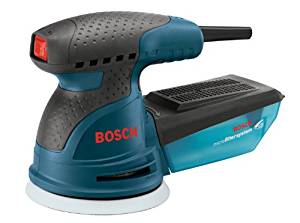
The Bosch ROS20VSC is ideal for smaller tasks. It is not designed to be used by professionals but homeowners. It has a 2.5Amp motor, to sustain and it is light so you need not worry about fatigue. This tool has variable speed which can vary from 7,500 to 12,000 orbits per minute. You can, therefore, find the right speed for any item you are working on. The pad orbit and rotation sander allow for fast removal leading to an ultra-smooth finish free of swirl marks. The onboard dust collection system is another top reason why you should purchase the Bosch ROS20VSC. It can filter even the smallest microns. Nevertheless, there have been some complaints with the dust collection system.
Chemical Paint Strippers
The characteristics of the surface and the type of paint used will determine the characteristics of paint to be used. Before you select a paint stripper, you need to understand the three types of strippers.
Biochemical strippers – manufactured from plant-derived solvents, biochemical strippers contain either terpene from citrus or pine, lactic acid from corn sugar or citric acid. They may induce some skin irritation.
Caustic Strippers – Caustic strippers are water based and often have a pH between 13 and 14. Iye is the active ingredient and it reacts with the oil component in the paint thereby loosening it and forming a soapy substance. The iye can either be Caustic Potash, or caustic soda and can cause skin burns and lung irritation.
Solvent Strippers – Finally, we have the more hazardous solvent strippers that work by dissolving the bond between the paint and the substrate making the paint bubble up. Methylene chloride is the key ingredient in the paint.
Below are our top paint strippers.
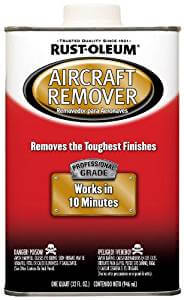
Rust-Oleum is ideal if you are dealing with tough finishes or you want to cover a large surface with minimal paint. It is designed such that the entire quart can strip paint off large surfaces and is also easy to clean using water. It’s non-flammable and acts fast making it ideal for projects that need to be hastily completed. It also works on any surface so you don’t have to worry about damaging your wood. Finally, it produces minimal fumes though they are toxic and can cause skin burns.
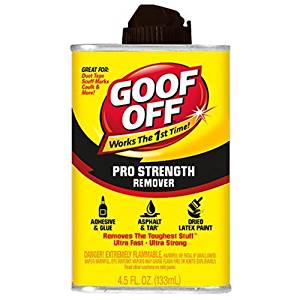
Consider this product if you are looking for top quality products. Goof off paint strippers are manufactured in the USA ensuring they are of top quality and that they meet safety standards. Using it will result in an elegant smooth finish. However, it has some shortcomings in that it has a terrible stench and it is highly flammable.
Conclusion
Ultimately, you want to select the right approach to remove paint from your wooden surface at an affordable price and using a means that leaves the wood in top shape. Comparing the various methods here, sanding is ideal but time-consuming. You can use heat but be careful not to damage the wood or hurt yourself. Chemical strippers should always be a last resort.
